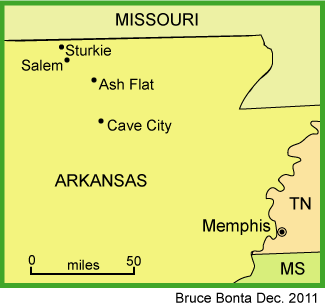With a typical can-do attitude, some Amish families in Sturkie, Arkansas, decided to erect a new bridge to overcome the fact that their small community was divided by the South Fork River.
 Moses Borntrager, on whose land the proposed construction was to take place, learned that an old steel bridge had been replaced by a new one up in Mendon, Missouri, 306 miles to the north, and it was sitting in a field of the farmer who had bought it for scrap. “If we’d known what we were getting into, we may not have done it,” Borntrager admitted as he surveyed the completed job recently.
Moses Borntrager, on whose land the proposed construction was to take place, learned that an old steel bridge had been replaced by a new one up in Mendon, Missouri, 306 miles to the north, and it was sitting in a field of the farmer who had bought it for scrap. “If we’d known what we were getting into, we may not have done it,” Borntrager admitted as he surveyed the completed job recently.
Leaders in the Sturkie Amish community were able to buy the old bridge and hire a company from the town of Ash Flat, Arkansas, to move it to Mr. Borntrager’s property. There, Amish helpers cut the bridge down from 18 feet to 12 feet wide, and they welded in steel beams to lengthen it from its original 70 feet to the 92 feet necessary to span the river. It took 65 hours of welding to get the bridge exactly right for its new home.
The Amish poured 40 cubic yards of concrete for the bridge to sit on. Then Paul Carter, from Cave City, AR, used his crane to haul the bridge across Borntrager’s pasture to the edge of the river. With workers holding ropes and helping maneuver it into place, Carter’s crane struggled to move the bridge onto its new supports. He admitted the structure was quite heavy for his crane, but he finished the job successfully.
Another local contractor built a road across the pasture and ramps up to the bridge to provide access from the public road. Another Amishman, John Shetler, cut 12 tons of lumber at his sawmill from trees on Amish property for the bridge decking.
State representative Lori Benedict, who lives in the area, expressed support for the project. “I’ve tried it out a couple of times,” she said about the bridge. “They did a great job as usual.”
Rep. Benedict has cited the growth of the Amish community in her arguments with the U.S. Postal Service opposing a proposal to close the Sturkie post office. She is defensive of Amish interests and envisions a future tourist draw from having them living and prospering in her district. She argues that it would be a bad idea to make them travel six and a half miles to the post office in the larger town of Salem.
The Amish are evidently expanding the businesses in the area. Mr. Borntrager makes harnesses, while other Amish families manage a country store, operate a blacksmith shop, make cabinets, and grow produce.